Winter Wheat Maturity Prediction via Sentinel-2 MSI Images
Abstract
:1. Introduction
2. Study Area and Dataset
2.1. Study Area
2.1.1. North China Plain
2.1.2. Winter Wheat Planting Area Labels
- Six hundred wheat cropland sample points, with 300 points in each P1 and P2 study area (Figure 1b);
- One hundred and fifty waterbody sample points;
- One hundred and fifty road sample points;
- One hundred and fifty urban area sample points;
- One hundred and fifty green vegetation-covered sample points.
2.2. Remote Sensing Images
2.2.1. Sentinel-2 MSI
2.2.2. GF-1 WFV and HJ-2 CCD
2.3. Winter Wheat Maturity Data Collection
2.3.1. Harvester Work Record
2.3.2. Manual Labeling of Harvest on the Basis of Remote Sensing Images
3. Methods
3.1. Methodological Framework
- (i)
- Winter wheat planting area classification. In this study, winter wheat planting areas were extracted via a multigrowth-stage NDVI combined with threshold methods.
- (ii)
- Winter wheat maturity characteristic analysis. We conducted a comprehensive analysis, selecting VIs (such as NDVI, NDRE, NDII1, and NDII2) and thoroughly examine the winter wheat maturity characteristics and field harvest characteristics via boxplot analysis methods.
- (iii)
- Winter wheat maturity data prediction. On the basis of the selected valuable harvest VIs, a threshold method was used to determine maturity, which was combined with the information extracted from the winter wheat planting area to assess the harvest progress.
3.2. Vegetation Indices
3.3. Winter Wheat Spectral Feature Analysis and Extraction Techniques
3.3.1. Time Series Vegetation Index Feature Analysis
- (i)
- Roads, water bodies, and urban areas had NDVI values below 0.3, with minimal interannual variation.
- (ii)
- Cropland pixels were influenced by the natural environment, seasonal changes, and human cultivation. Wheat emerged at the end of October of the previous year, with the NDVI peaking at the end of April of the following year and decreasing to its lowest value by the end of May.
- (iii)
- In non-crop vegetation-covered areas, the NDVI values were influenced by the natural environment and seasonal changes. The NDVI values began to rise in March, peaked in June, decreased in November, and reached their lowest values by the end of December.
3.3.2. Boxplot
3.4. Maturity Prediction Model
- Strategy (1) used VIs from the emergence stage to the flowering stage (S1–S9, nine growth periods) for maturity prediction. Strategy (1) enabled the prediction of wheat maturity at the flowering stage (29 April 2023, Table 2). For maturity prediction via Strategy 1, each validation unit corresponded to 12 × 9 = 108 modeling values.
- Strategy (2) used VIs from the emergence stage to the filling stage (S1–S10, ten growth periods) for maturity prediction. Strategy (2) enabled the prediction of wheat maturity at the filling stage (14 May 2023, Table 2). For Strategy 2, each validation unit corresponded to 12 × 10 = 120 modeling values.
3.5. Performance Evaluation
3.5.1. Performance Evaluation of Winter Wheat Planting Areas Extraction
3.5.2. Performance Evaluation of Winter Wheat Maturity Prediction
4. Results
4.1. Analysis of Winter Wheat Maturation Features
4.2. Extraction of Winter Wheat Planting Areas
4.3. Winter Wheat Maturity Prediction
5. Analysis and Discussion
5.1. Winter Wheat Planting Area Extraction Model
5.2. Winter Wheat Maturity Prediction Model
5.3. Limitations and Uncertainty of This Work
6. Conclusions
- (i)
- Integration of the NDVI of the (a) jointing-heading and (b) maturation-harvesting stages can provide high-precision extraction of winter wheat planting areas.
- (ii)
- Utilizing the MSR model, RF model, and multitemporal multispectral remote sensing data enables high-performance prediction of winter wheat maturity. The proposed method offers the highest accuracy in predicting maturity at the winter wheat flowering stage, aiding in a timely and comprehensive understanding of the winter wheat maturity and in deploying large-scale harvesters within the region.
Author Contributions
Funding
Institutional Review Board Statement
Data Availability Statement
Conflicts of Interest
Appendix A
| Strategies | Strategy (1) | Strategy (2) | Strategies | Strategy (1) | Strategy (2) | ||||||
|---|---|---|---|---|---|---|---|---|---|---|---|
| Models | MSR | PLSR | MSR | PLSR | Models | MSR | PLSR | MSR | PLSR | ||
| Constants | 3.001 | 6.397 | 5.967 | 5.918 | - | - | - | - | - | ||
| S1 | GNDVI | 0.000 | 0.280 | 0.000 | 0.436 | S6 | GNDVI | 0.000 | −0.821 | 0.000 | −1.069 |
| NDVI | 0.000 | −0.504 | 5.765 | −0.567 | NDVI | 0.000 | −0.634 | 0.000 | −0.859 | ||
| NDVI2 | 0.000 | −0.037 | 0.000 | −0.017 | NDVI2 | −13.718 | −0.488 | −18.668 | −0.630 | ||
| RDVI | 0.000 | 0.288 | 0.000 | 0.436 | RDVI | 0.000 | −0.447 | 0.000 | −0.632 | ||
| SAVI | 0.000 | 0.427 | 0.000 | 0.604 | SAVI | 0.000 | −0.396 | 0.000 | −0.565 | ||
| OSAVI | 0.000 | −0.110 | 0.000 | −0.071 | OSAVI | 0.000 | −0.524 | 0.000 | −0.724 | ||
| EVI | 0.000 | −0.993 | 0.000 | −0.722 | EVI | 52.601 | −0.587 | 0.000 | −1.081 | ||
| CIRE | 0.000 | 0.244 | 0.000 | 0.359 | CIRE | 0.830 | −0.014 | 0.000 | 0.001 | ||
| NDRE | 0.000 | −0.267 | 0.000 | −0.175 | NDRE | −25.486 | −0.485 | 0.000 | −0.630 | ||
| NDII1 | −4.533 | −0.969 | 0.000 | −1.459 | NDII1 | 31.536 | −0.156 | 39.474 | −0.166 | ||
| NDII2 | 0.000 | −1.114 | −7.869 | −1.454 | NDII2 | 0.000 | −0.471 | 0.000 | −0.593 | ||
| NIRV | 0.000 | 2.172 | 0.000 | 2.775 | NIRV | 0.000 | −0.268 | 0.000 | −0.348 | ||
| S2 | GNDVI | 0.000 | 0.691 | 0.000 | 0.882 | S7 | GNDVI | 16.028 | 1.263 | 15.582 | 1.554 |
| NDVI | 0.000 | 0.204 | 0.000 | 0.226 | NDVI | 0.000 | 0.647 | 28.630 | 0.701 | ||
| NDVI2 | 0.000 | 0.328 | 0.000 | 0.409 | NDVI2 | 0.000 | 0.976 | 0.000 | 1.181 | ||
| RDVI | 0.000 | 0.375 | 0.000 | 0.394 | RDVI | 0.000 | 1.143 | 0.000 | 1.406 | ||
| SAVI | 0.000 | 0.341 | 0.000 | 0.352 | SAVI | 0.000 | 1.077 | 0.000 | 1.322 | ||
| OSAVI | 0.000 | 0.251 | 0.000 | 0.260 | OSAVI | 0.000 | 0.841 | 0.000 | 0.981 | ||
| EVI | 0.000 | −0.122 | 0.000 | −0.382 | EVI | 0.000 | −0.500 | 0.000 | −1.103 | ||
| CIRE | 0.000 | 0.207 | 0.000 | 0.269 | CIRE | 0.000 | 0.099 | 0.000 | 0.152 | ||
| NDRE | 25.320 | 0.819 | 23.703 | 0.967 | NDRE | 0.000 | 0.819 | −43.237 | 1.000 | ||
| NDII1 | 0.000 | 0.340 | 0.000 | 0.335 | NDII1 | 0.000 | 0.434 | 0.000 | 0.574 | ||
| NDII2 | 0.000 | −0.026 | 0.000 | −0.076 | NDII2 | 0.000 | 0.191 | 0.000 | 0.199 | ||
| NIRV | 0.000 | 0.806 | 0.000 | 0.934 | NIRV | 0.000 | 1.906 | 0.000 | 2.507 | ||
| S3 | GNDVI | 0.000 | −0.579 | 0.000 | −0.639 | S8 | GNDVI | 0.000 | 0.895 | 0.000 | 1.243 |
| NDVI | 0.000 | −0.512 | 0.000 | −0.606 | NDVI | 0.000 | −0.047 | 0.000 | 0.003 | ||
| NDVI2 | 0.000 | −0.065 | 0.000 | −0.037 | NDVI2 | 0.000 | 0.548 | 0.000 | 0.774 | ||
| RDVI | 0.000 | −0.245 | 0.000 | −0.307 | RDVI | 0.000 | 0.768 | 0.000 | 1.154 | ||
| SAVI | 0.000 | −0.207 | 0.000 | −0.266 | SAVI | 0.000 | 0.735 | 0.000 | 1.099 | ||
| OSAVI | 0.000 | −0.358 | 0.000 | −0.437 | OSAVI | 0.000 | 0.318 | 0.000 | 0.514 | ||
| EVI | −77.441 | −1.976 | −70.848 | −2.540 | EVI | 0.000 | −2.677 | 0.000 | −2.833 | ||
| CIRE | 0.000 | 0.038 | 0.000 | 0.043 | CIRE | 0.000 | 0.151 | 0.000 | 0.227 | ||
| NDRE | 0.000 | −0.075 | 0.000 | −0.169 | NDRE | 0.000 | 1.068 | 22.872 | 1.459 | ||
| NDII1 | 0.000 | −0.326 | 0.000 | −0.495 | NDII1 | 0.000 | 0.242 | −17.831 | 0.405 | ||
| NDII2 | 8.013 | −0.518 | 0.000 | −0.675 | NDII2 | 0.000 | −0.082 | 0.000 | −0.060 | ||
| NIRV | 0.000 | 0.341 | 0.000 | 0.429 | NIRV | 0.000 | 1.822 | 0.000 | 2.636 | ||
| S4 | GNDVI | 0.000 | −0.077 | 0.000 | −0.026 | S9 | GNDVI | 0.000 | −1.204 | −14.801 | −1.119 |
| NDVI | 0.000 | −0.481 | 0.000 | −0.509 | NDVI | 0.000 | −1.458 | 0.000 | −1.480 | ||
| NDVI2 | 0.000 | −0.264 | 0.000 | −0.262 | NDVI2 | 0.000 | −0.931 | 0.000 | −0.838 | ||
| RDVI | 0.000 | −0.368 | 0.000 | −0.395 | RDVI | 0.000 | −0.911 | 0.000 | −0.476 | ||
| SAVI | 0.000 | −0.341 | 0.000 | −0.368 | SAVI | 0.000 | −0.788 | 0.000 | −0.350 | ||
| OSAVI | 0.000 | −0.418 | 0.000 | −0.449 | OSAVI | 0.000 | −1.162 | 0.000 | −0.971 | ||
| EVI | 0.000 | −2.165 | 0.000 | −2.393 | EVI | 0.000 | −1.059 | 0.000 | 0.699 | ||
| CIRE | −1.000 | −0.113 | 0.000 | −0.157 | CIRE | 0.000 | 0.129 | 0.835 | 0.219 | ||
| NDRE | 0.000 | −1.077 | 0.000 | −1.258 | NDRE | 0.000 | 0.251 | 0.000 | 0.761 | ||
| NDII1 | 0.000 | −0.848 | 0.000 | −0.949 | NDII1 | 0.000 | 0.019 | 0.000 | 0.634 | ||
| NDII2 | 0.000 | −0.763 | 0.000 | −0.860 | NDII2 | 0.000 | −0.415 | 0.000 | −0.095 | ||
| NIRV | 0.000 | −0.056 | 0.000 | −0.040 | NIRV | −11.468 | −0.092 | 0.000 | 0.870 | ||
| S5 | GNDVI | 0.000 | −0.680 | 0.000 | −0.830 | S10 | GNDVI | 0.000 | 0.180 | ||
| NDVI | 0.000 | −0.767 | 0.000 | −0.962 | NDVI | 0.000 | −0.577 | ||||
| NDVI2 | 0.000 | −0.589 | −7.182 | −0.760 | NDVI2 | 0.000 | 0.108 | ||||
| RDVI | 0.000 | −0.608 | 0.000 | −0.761 | RDVI | 0.000 | 0.344 | ||||
| SAVI | 0.000 | −0.544 | 0.000 | −0.684 | SAVI | 0.000 | 0.419 | ||||
| OSAVI | 0.000 | −0.674 | 0.000 | −0.851 | OSAVI | 0.000 | −0.117 | ||||
| EVI | 0.000 | −2.654 | 0.000 | −3.269 | EVI | 0.000 | −0.467 | ||||
| CIRE | 0.000 | −0.101 | 0.000 | −0.128 | CIRE | 0.665 | 0.311 | ||||
| NDRE | 0.000 | −0.999 | 0.000 | −1.214 | NDRE | 0.000 | 1.600 | ||||
| NDII1 | 0.000 | −0.892 | 0.000 | −1.120 | NDII1 | 0.000 | 1.868 | ||||
| NDII2 | −30.131 | −0.884 | −23.086 | −1.087 | NDII2 | 0.000 | 0.595 | ||||
| NIRV | 23.287 | −0.320 | 32.302 | −0.378 | NIRV | 0.000 | 1.772 | ||||
References
- Hazard, B.; Trafford, K.; Lovegrove, A.; Griffiths, S.; Uauy, C.; Shewry, P. Strategies to Improve Wheat for Human Health. Nat. Food 2020, 1, 475–480. [Google Scholar] [CrossRef]
- Asseng, S.; Ewert, F.; Martre, P.; Rötter, R.P.; Lobell, D.B.; Cammarano, D.; Kimball, B.A.; Ottman, M.J.; Wall, G.W.; White, J.W.; et al. Rising Temperatures Reduce Global Wheat Production. Nat. Clim. Chang. 2015, 5, 143–147. [Google Scholar] [CrossRef]
- Wang, S.; Mo, X.; Liu, Z.; Baig, M.H.A.; Chi, W. Understanding Long-Term (1982–2013) Patterns and Trends in Winter Wheat Spring Green-up Date over the North China Plain. Int. J. Appl. Earth Obs. Geoinf. 2017, 57, 235–244. [Google Scholar] [CrossRef]
- Li, F.; Miao, Y.; Feng, G.; Yuan, F.; Yue, S.; Gao, X.; Liu, Y.; Liu, B.; Ustin, S.L.; Chen, X. Improving Estimation of Summer Maize Nitrogen Status with Red Edge-Based Spectral Vegetation Indices. Field Crops Res. 2014, 157, 111–123. [Google Scholar] [CrossRef]
- Tao, G.; Jia, K.; Wei, X.; Xia, M.; Wang, B.; Xie, X.; Jiang, B.; Yao, Y.; Zhang, X. Improving the Spatiotemporal Fusion Accuracy of Fractional Vegetation Cover in Agricultural Regions by Combining Vegetation Growth Models. Int. J. Appl. Earth Obs. Geoinf. 2021, 101, 102362. [Google Scholar] [CrossRef]
- Yue, J.; Tian, Q.; Liu, Y.; Fu, Y.; Tian, J.; Zhou, C.; Feng, H.; Yang, G. Mapping Cropland Rice Residue Cover Using a Radiative Transfer Model and Deep Learning. Comput. Electron. Agric. 2023, 215, 108421. [Google Scholar] [CrossRef]
- Yue, J.; Tian, J.; Philpot, W.; Tian, Q.; Feng, H.; Fu, Y. VNAI-NDVI-Space and Polar Coordinate Method for Assessing Crop Leaf Chlorophyll Content and Fractional Cover. Comput. Electron. Agric. 2023, 207, 107758. [Google Scholar] [CrossRef]
- Wang, L.; Gao, R.; Li, C.; Wang, J.; Liu, Y.; Hu, J.; Li, B.; Qiao, H.; Feng, H.; Yue, J. Mapping Soybean Maturity and Biochemical Traits Using UAV-Based Hyperspectral Images. Remote Sens. 2023, 15, 4807. [Google Scholar] [CrossRef]
- Lindsey, A.J.; Craft, J.C.; Barker, D.J. Modeling Canopy Senescence to Calculate Soybean Maturity Date Using NDVI. Crop Sci. 2020, 60, 172–180. [Google Scholar] [CrossRef]
- Trevisan, R.; Pérez, O.; Schmitz, N.; Diers, B.; Martin, N. High-Throughput Phenotyping of Soybean Maturity Using Time Series UAV Imagery and Convolutional Neural Networks. Remote Sens. 2020, 12, 3617. [Google Scholar] [CrossRef]
- Diao, C. Remote Sensing Phenological Monitoring Framework to Characterize Corn and Soybean Physiological Growing Stages. Remote Sens. Environ. 2020, 248, 111960. [Google Scholar] [CrossRef]
- Yue, J.; Yang, G.; Li, C.; Li, Z.; Wang, Y.; Feng, H.; Xu, B. Estimation of Winter Wheat Above-Ground Biomass Using Unmanned Aerial Vehicle-Based Snapshot Hyperspectral Sensor and Crop Height Improved Models. Remote Sens. 2017, 9, 708. [Google Scholar] [CrossRef]
- Yue, J.; Yang, H.; Yang, G.; Fu, Y.; Wang, H.; Zhou, C. Estimating Vertically Growing Crop Above-Ground Biomass Based on UAV Remote Sensing. Comput. Electron. Agric. 2023, 205, 107627. [Google Scholar] [CrossRef]
- Yue, J.; Yang, G.; Li, C.; Liu, Y.; Wang, J.; Guo, W.; Ma, X.; Niu, Q.; Qiao, H.; Feng, H. Analyzing Winter-Wheat Biochemical Traits Using Hyperspectral Remote Sensing and Deep Learning. Comput. Electron. Agric. 2024, 222, 109026. [Google Scholar] [CrossRef]
- Yue, J.; Feng, H.; Li, Z.; Zhou, C.; Xu, K. Mapping Winter-Wheat Biomass and Grain Yield Based on a Crop Model and UAV Remote Sensing. Int. J. Remote Sens. 2021, 42, 1577–1601. [Google Scholar] [CrossRef]
- Wu, B.; Zhang, M.; Zeng, H.; Tian, F.; Potgieter, A.B.; Qin, X.; Yan, N.; Chang, S.; Zhao, Y.; Dong, Q.; et al. Challenges and Opportunities in Remote Sensing-Based Crop Monitoring: A Review. Natl. Sci. Rev. 2023, 10, nwac290. [Google Scholar] [CrossRef] [PubMed]
- Lalechère, E.; Monnet, J.-M.; Breen, J.; Fuhr, M. Assessing the Potential of Remote Sensing-Based Models to Predict Old-Growth Forests on Large Spatiotemporal Scales. J. Environ. Manag. 2024, 351, 119865. [Google Scholar] [CrossRef] [PubMed]
- Zhao, Y.; Xiao, D.; Bai, H. The Simultaneous Prediction of Yield and Maturity Date for Wheat–Maize by Combining Satellite Images with Crop Model. J. Sci. Food Agric. 2024. Jun (Early Access). [Google Scholar] [CrossRef] [PubMed]
- d’Andrimont, R.; Taymans, M.; Lemoine, G.; Ceglar, A.; Yordanov, M.; van der Velde, M. Detecting Flowering Phenology in Oil Seed Rape Parcels with Sentinel-1 and -2 Time Series. Remote Sens. Environ. 2020, 239, 111660. [Google Scholar] [CrossRef]
- Belaqziz, S.; Khabba, S.; Kharrou, M.H.; Bouras, E.H.; Er-Raki, S.; Chehbouni, A. Optimizing the Sowing Date to Improve Water Management and Wheat Yield in a Large Irrigation Scheme, through a Remote Sensing and an Evolution Strategy-Based Approach. Remote Sens. 2021, 13, 3789. [Google Scholar] [CrossRef]
- Gao, F.; Zhang, X. Mapping Crop Phenology in Near Real-Time Using Satellite Remote Sensing: Challenges and Opportunities. J. Remote Sens. 2021, 2021, 8379391. [Google Scholar] [CrossRef]
- Zhang, M.; Abrahao, G.; Cohn, A.; Campolo, J.; Thompson, S. A MODIS-Based Scalable Remote Sensing Method to Estimate Sowing and Harvest Dates of Soybean Crops in Mato Grosso, Brazil. Heliyon 2021, 7, e07436. [Google Scholar] [CrossRef]
- Islam, M.M.; Matsushita, S.; Noguchi, R.; Ahamed, T. Development of Remote Sensing-Based Yield Prediction Models at the Maturity Stage of Boro Rice Using Parametric and Nonparametric Approaches. Remote Sens. Appl. Soc. Environ. 2021, 22, 100494. [Google Scholar] [CrossRef]
- Zafar, Z.; Zubair, M.; Zha, Y.; Fahd, S.; Ahmad Nadeem, A. Performance Assessment of Machine Learning Algorithms for Mapping of Land Use/Land Cover Using Remote Sensing Data. Egypt. J. Remote Sens. Space Sci. 2024, 27, 216–226. [Google Scholar] [CrossRef]
- Chang, Z.; Li, H.; Chen, D.; Liu, Y.; Zou, C.; Chen, J.; Han, W.; Liu, S.; Zhang, N. Crop Type Identification Using High-Resolution Remote Sensing Images Based on an Improved DeepLabV3+ Network. Remote Sens. 2023, 15, 5088. [Google Scholar] [CrossRef]
- Dong, J.; Fu, Y.; Wang, J.; Tian, H.; Fu, S.; Niu, Z.; Han, W.; Zheng, Y.; Huang, J.; Yuan, W. Early-Season Mapping of Winter Wheat in China Based on Landsat and Sentinel Images. Earth Syst. Sci. Data 2020, 12, 3081–3095. [Google Scholar] [CrossRef]
- Ayhan, B.; Kwan, C. Tree, Shrub, and Grass Classification Using Only RGB Images. Remote Sens. 2020, 12, 1333. [Google Scholar] [CrossRef]
- Yue, J.; Feng, H.; Yang, G.; Li, Z. A Comparison of Regression Techniques for Estimation of Above-Ground Winter Wheat Biomass Using Near-Surface Spectroscopy. Remote Sens. 2018, 10, 66. [Google Scholar] [CrossRef]
- Sun, J.; Di, L.; Sun, Z.; Shen, Y.; Lai, Z. County-Level Soybean Yield Prediction Using Deep CNN-LSTM Model. Sensors 2019, 19, 4363. [Google Scholar] [CrossRef]
- Amherdt, S.; Nieto, L.; Carcedo, A.J.P.; Pereira, A.; Cornero, C.; Ciampitti, I.A. Field Maturity Detection via Interferometric Synthetic Aperture Radar Images Time-Series: A Case Study for Maize Crop. Int. J. Remote Sens. 2023, 44, 1417–1432. [Google Scholar] [CrossRef]
- Ma, Y.; Jiang, Q.; Wu, X.; Zhu, R.; Gong, Y.; Peng, Y.; Duan, B.; Fang, S. Monitoring Hybrid Rice Phenology at Initial Heading Stage Based on Low-Altitude Remote Sensing Data. Remote Sens. 2020, 13, 86. [Google Scholar] [CrossRef]
- Zhao, F.; Yang, G.; Yang, H.; Long, H.; Xu, W.; Zhu, Y.; Meng, Y.; Han, S.; Liu, M. A Method for Prediction of Winter Wheat Maturity Date Based on MODIS Time Series and Accumulated Temperature. Agriculture 2022, 12, 945. [Google Scholar] [CrossRef]
- Diao, C.; Li, G. Near-Surface and High-Resolution Satellite Time Series for Detecting Crop Phenology. Remote Sens. 2022, 14, 1957. [Google Scholar] [CrossRef]
- Shen, Y.; Zhang, X.; Yang, Z. Mapping Corn and Soybean Phenometrics at Field Scales over the United States Corn Belt by Fusing Time Series of Landsat 8 and Sentinel-2 Data with VIIRS Data. ISPRS J. Photogramm. Remote Sens. 2022, 186, 55–69. [Google Scholar] [CrossRef]
- Zhao, Y.; Wang, X.; Hou, X.; Zhang, A. Spatio-Temporal Characteristics of Key Phenology of Winter Wheat in Shandong Province from 2003 to 2019. Acta Ecol. Sin. 2021, 41, 7785–7795. [Google Scholar] [CrossRef]
- Sakamoto, T. Refined Shape Model Fitting Methods for Detecting Various Types of Phenological Information on Major U.S. Crops. ISPRS J. Photogramm. Remote Sens. 2018, 138, 176–192. [Google Scholar] [CrossRef]
- Atkinson, P.M.; Jeganathan, C.; Dash, J.; Atzberger, C. Inter-Comparison of Four Models for Smoothing Satellite Sensor Time-Series Data to Estimate Vegetation Phenology. Remote Sens. Environ. 2012, 123, 400–417. [Google Scholar] [CrossRef]
- Zhu, L.; Si, R.; Shen, X.; Walker, J.P. An Advanced Change Detection Method for Time-Series Soil Moisture Retrieval from Sentinel-1. Remote Sens. Environ. 2022, 279, 113137. [Google Scholar] [CrossRef]
- Liu, L.; Zhang, X.; Yu, Y.; Guo, W. Real-Time and Short-Term Predictions of Spring Phenology in North America from VIIRS Data. Remote Sens. Environ. 2017, 194, 89–99. [Google Scholar] [CrossRef]
- Ji, H.; He, X.; Wang, W.; Zhang, H. Prediction of Winter Wheat Harvest Based on Back Propagation Neural Network Algorithm and Multiple Remote Sensing Indices. Processes 2023, 11, 293. [Google Scholar] [CrossRef]
- Ji, Z.; Pan, Y.; Zhu, X.; Wang, J.; Li, Q. Prediction of Crop Yield Using Phenological Information Extracted from Remote Sensing Vegetation Index. Sensors 2021, 21, 1406. [Google Scholar] [CrossRef]
- Teodoro, P.E.; Teodoro, L.P.R.; Baio, F.H.R.; da Silva Junior, C.A.; dos Santos, R.G.; Ramos, A.P.M.; Pinheiro, M.M.F.; Osco, L.P.; Gonçalves, W.N.; Carneiro, A.M.; et al. Predicting Days to Maturity, Plant Height, and Grain Yield in Soybean: A Machine and Deep Learning Approach Using Multispectral Data. Remote Sens. 2021, 13, 4632. [Google Scholar] [CrossRef]
- Campos-Taberner, M.; Moreno-Martínez, Á.; García-Haro, F.J.; Camps-Valls, G.; Robinson, N.P.; Kattge, J.; Running, S.W. Global Estimation of Biophysical Variables from Google Earth Engine Platform. Remote Sens. 2018, 10, 1167. [Google Scholar] [CrossRef]
- Jia, K.; Liang, S.; Gu, X.; Baret, F.; Wei, X.; Wang, X.; Yao, Y.; Yang, L.; Li, Y. Fractional Vegetation Cover Estimation Algorithm for Chinese GF-1 Wide Field View Data. Remote Sens. Environ. 2016, 177, 184–191. [Google Scholar] [CrossRef]
- Bian, J.; Li, A.; Zhang, Z.; Zhao, W.; Lei, G.; Yin, G.; Jin, H.; Tan, J.; Huang, C. Monitoring Fractional Green Vegetation Cover Dynamics over a Seasonally Inundated Alpine Wetland Using Dense Time Series HJ-1A/B Constellation Images and an Adaptive Endmember Selection LSMM Model. Remote Sens. Environ. 2017, 197, 98–114. [Google Scholar] [CrossRef]
- ENVI ENVI Tutorials. Available online: https://www.nv5geospatialsoftware.com/docs/tutorials.html (accessed on 10 June 2024).
- Wang, J.; Zhao, C.; Huang, W. Fundamental and Application of Quantitative Remote Sensing in Agriculture; Science China Press: Beijing, China, 2008. [Google Scholar]
- Rouse, J.W.; Hass, R.H.; Schell, J.A.; Deering, D.W. Monitoring Vegetation Systems in the Great Plains with ERTS. NASA Spec. Publ. 1974, 351, 309–317. [Google Scholar]
- Haghighattalab, A.; González Pérez, L.; Mondal, S.; Singh, D.; Schinstock, D.; Rutkoski, J.; Ortiz-Monasterio, I.; Singh, R.P.; Goodin, D.; Poland, J. Application of Unmanned Aerial Systems for High Throughput Phenotyping of Large Wheat Breeding Nurseries. Plant Methods 2016, 12, 35. [Google Scholar] [CrossRef]
- Yan, K.; Gao, S.; Chi, H.; Qi, J.; Song, W.; Tong, Y.; Mu, X.; Yan, G. Evaluation of the Vegetation-Index-Based Dimidiate Pixel Model for Fractional Vegetation Cover Estimation. IEEE Trans. Geosci. Remote Sens. 2022, 60, 1–14. [Google Scholar] [CrossRef]
- Huete, A.R. A Soil-Adjusted Vegetation Index (SAVI). Remote Sens. Environ. 1988, 25, 295–309. [Google Scholar] [CrossRef]
- Rondeaux, G.; Steven, M.; Baret, F. Optimization of Soil-Adjusted Vegetation Indices. Remote Sens. Environ. 1996, 55, 95–107. [Google Scholar] [CrossRef]
- Hornero, A.; North, P.R.J.; Zarco-Tejada, P.J.; Rascher, U.; Martín, M.P.; Migliavacca, M.; Hernandez-Clemente, R. Assessing the Contribution of Understory Sun-Induced Chlorophyll Fluorescence through 3-D Radiative Transfer Modelling and Field Data. Remote Sens. Environ. 2021, 253, 112195. [Google Scholar] [CrossRef]
- Jiang, Z.; Huete, A.R.; Didan, K.; Miura, T. Development of a Two-Band Enhanced Vegetation Index without a Blue Band. Remote Sens. Environ. 2008, 112, 3833–3845. [Google Scholar] [CrossRef]
- Gitelson, A.A.; Gritz, Y.; Merzlyak, M.N. Relationships between Leaf Chlorophyll Content and Spectral Reflectance and Algorithms for Non-Destructive Chlorophyll Assessment in Higher Plant Leaves. J. Plant Physiol. 2003, 160, 271–282. [Google Scholar] [CrossRef]
- Barnes, E.M.; Clarke, T.R.; Richards, S.E.; Colaizzi, P.D.; Haberland, J.; Kostrzewski, M.; Waller, P.; Choi, C.; Riley, E.; Thompson, T.; et al. Coincident Detection of Crop Water Stress, Nitrogen Status and Canopy Density Using Ground Based Multispectral Data. In Proceedings of the 5th International Conference on Precision Agriculture and other resource management, Bloomington, MN, USA, 16–19 July 2000. [Google Scholar]
- Hardisky, M.A.; Klemas, V.; Smart, R.M. The Influence of Soil Salinity, Growth Form, and Leaf Moisture on the Spectral Radiance of Spartina Alterniflora Canopies. Photogramm. Eng. Remote Sens. 1983, 49, 77–83. [Google Scholar]
- Kampstra, P. Beanplot: A Boxplot Alternative for Visual Comparison of Distributions. J. Stat. Softw. 2008, 28, 1–9. [Google Scholar] [CrossRef]
- Breiman, L. Random Forests. Mach. Learn. 2001, 45, 5–32. [Google Scholar] [CrossRef]
- Wold, H. Estimation of Principal Components and Related Models by Iterative Least Squares in Multivariate Analysis. Multivar. Anal. 1966, 391–420. [Google Scholar]
- Olofsson, P.; Foody, G.M.; Herold, M.; Stehman, S.V.; Woodcock, C.E.; Wulder, M.A. Good Practices for Estimating Area and Assessing Accuracy of Land Change. Remote Sens. Environ. 2014, 148, 42–57. [Google Scholar] [CrossRef]
- Zhu, X. Agricultural Utilization of Water Resources in North China Plain. World Surv. Res. 1998, 4, 9–12. [Google Scholar]
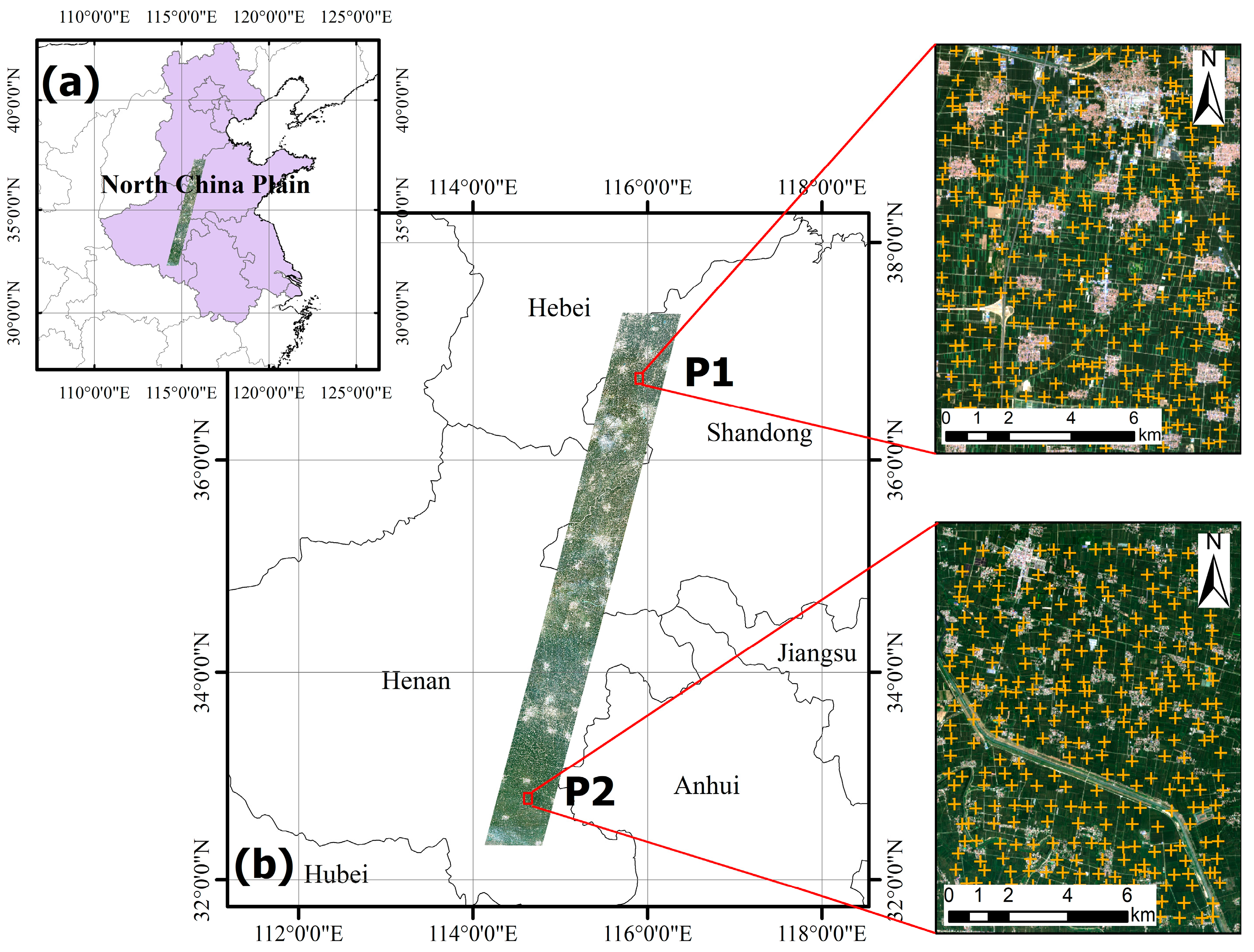
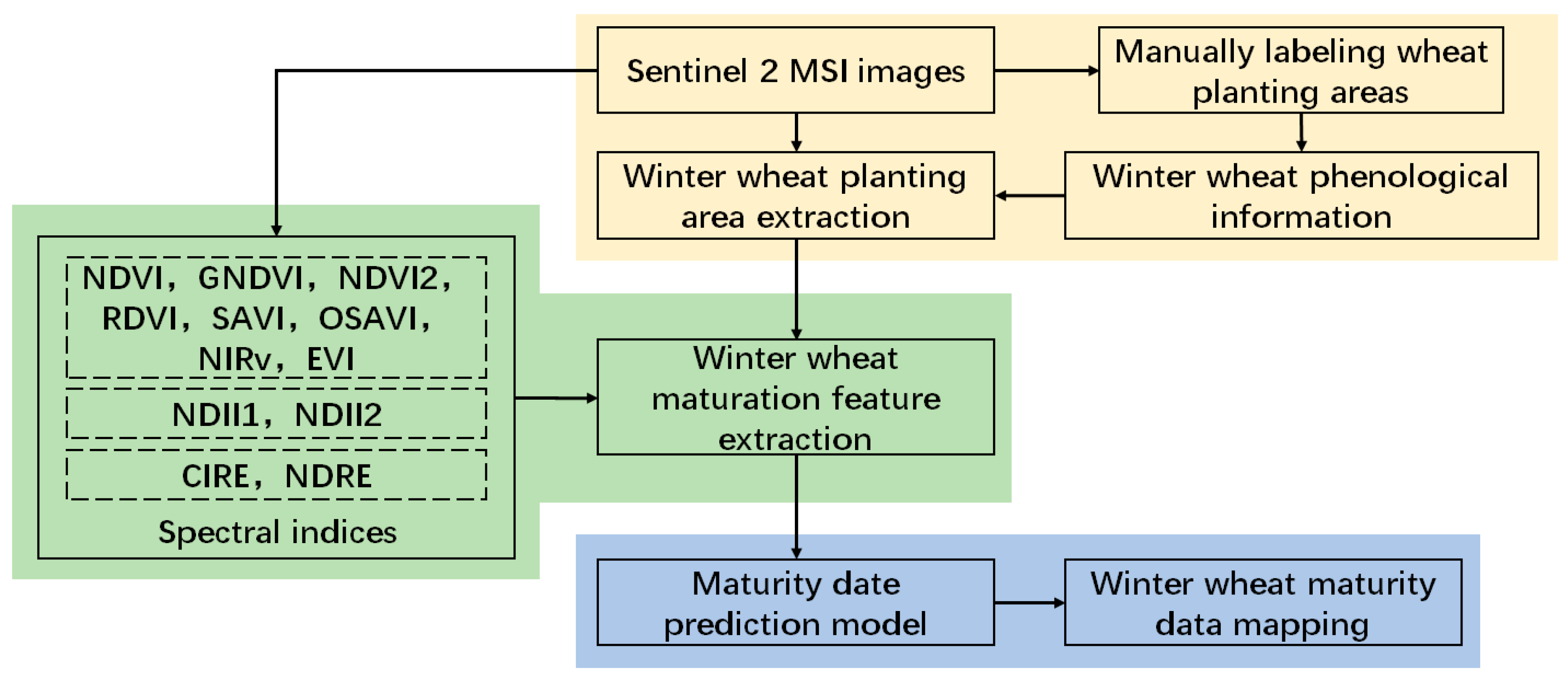


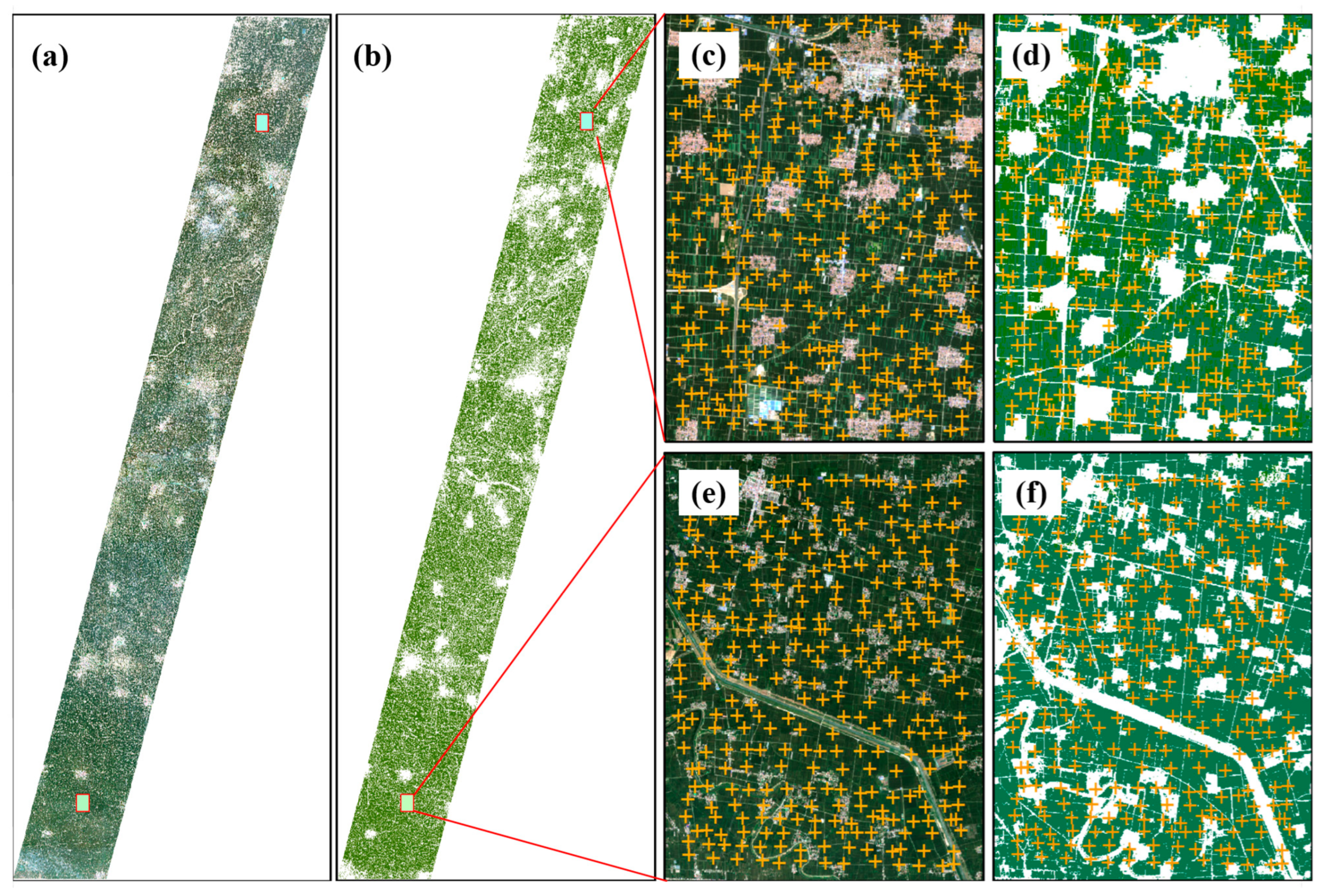
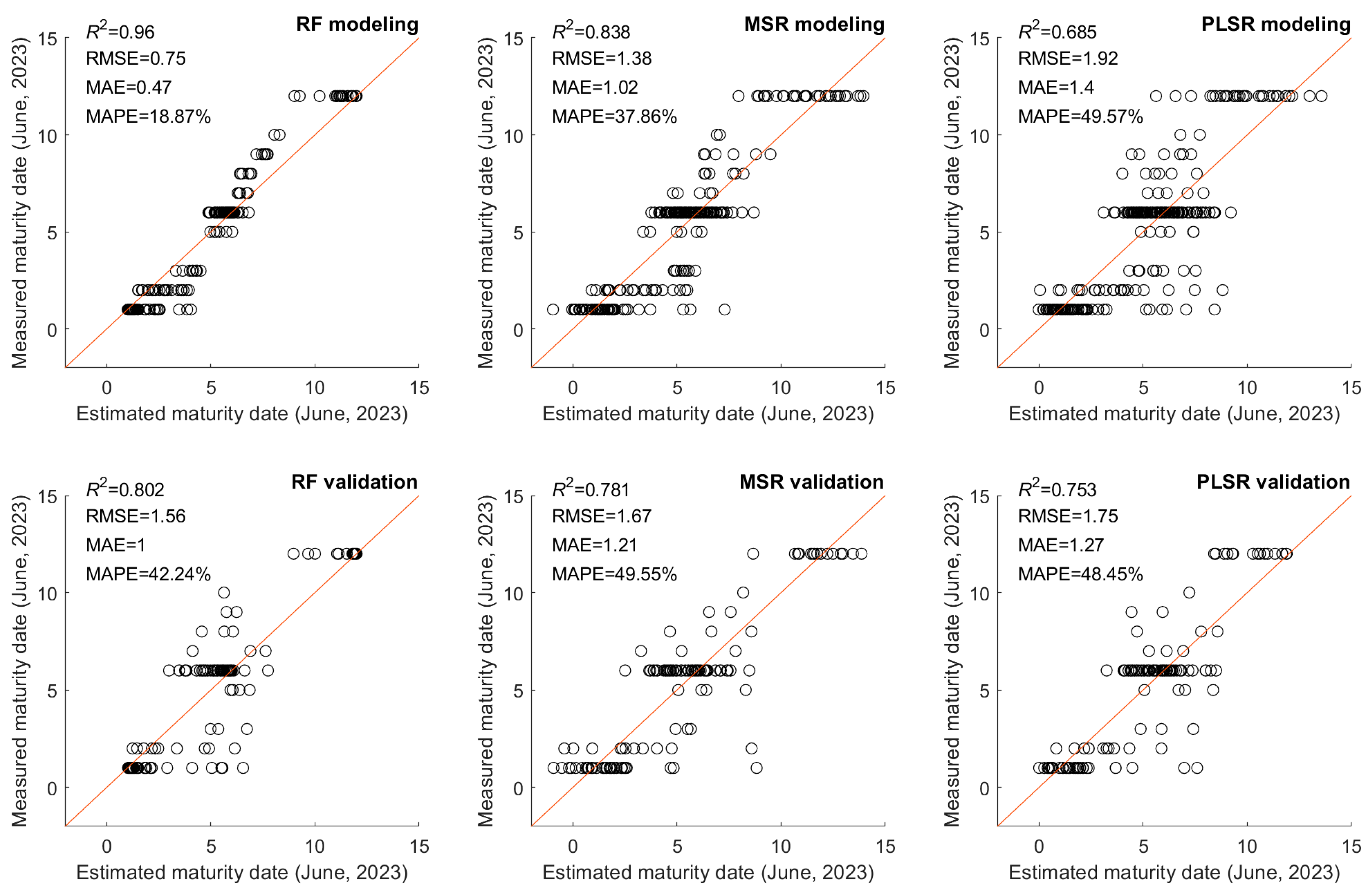
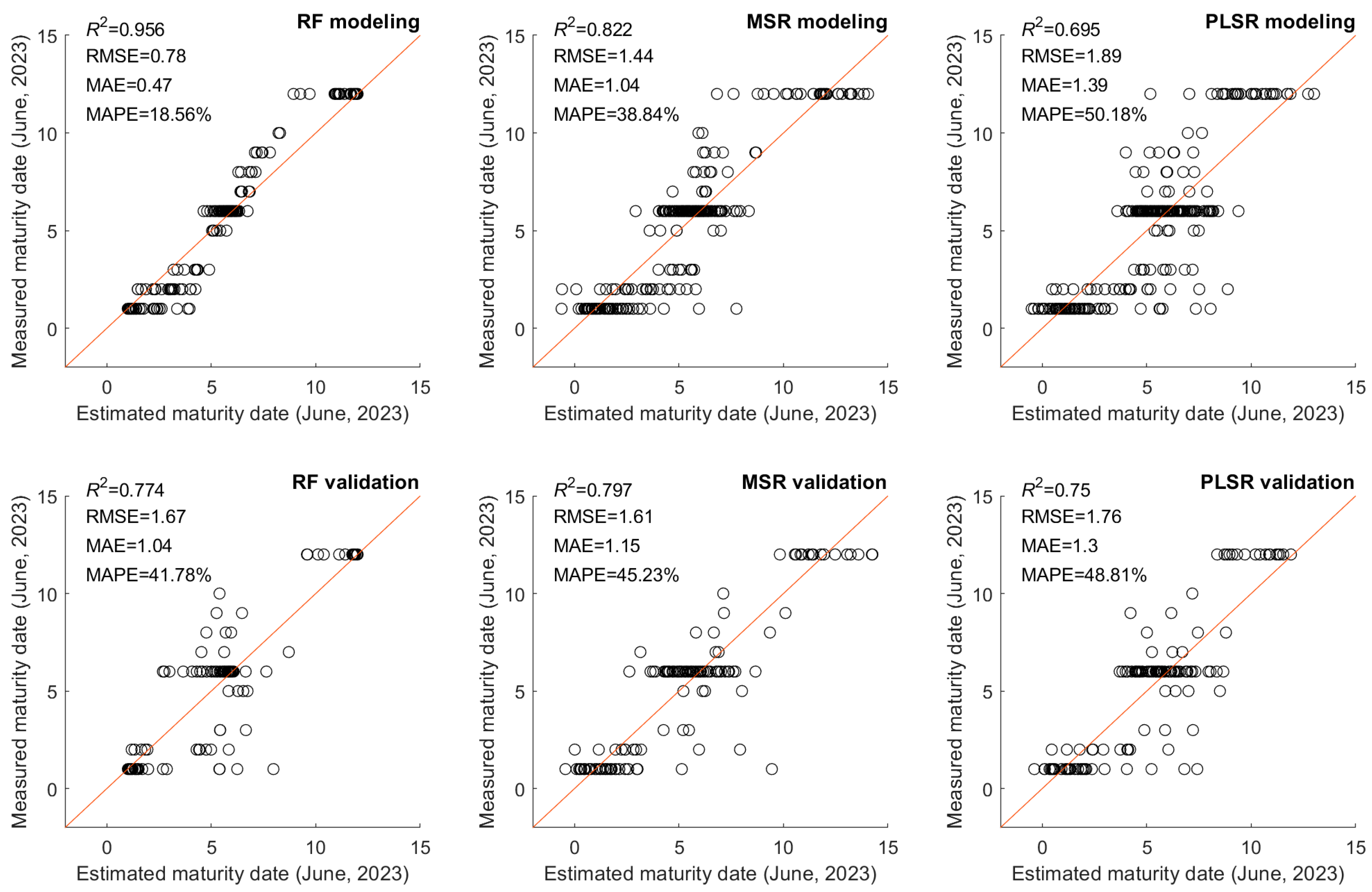
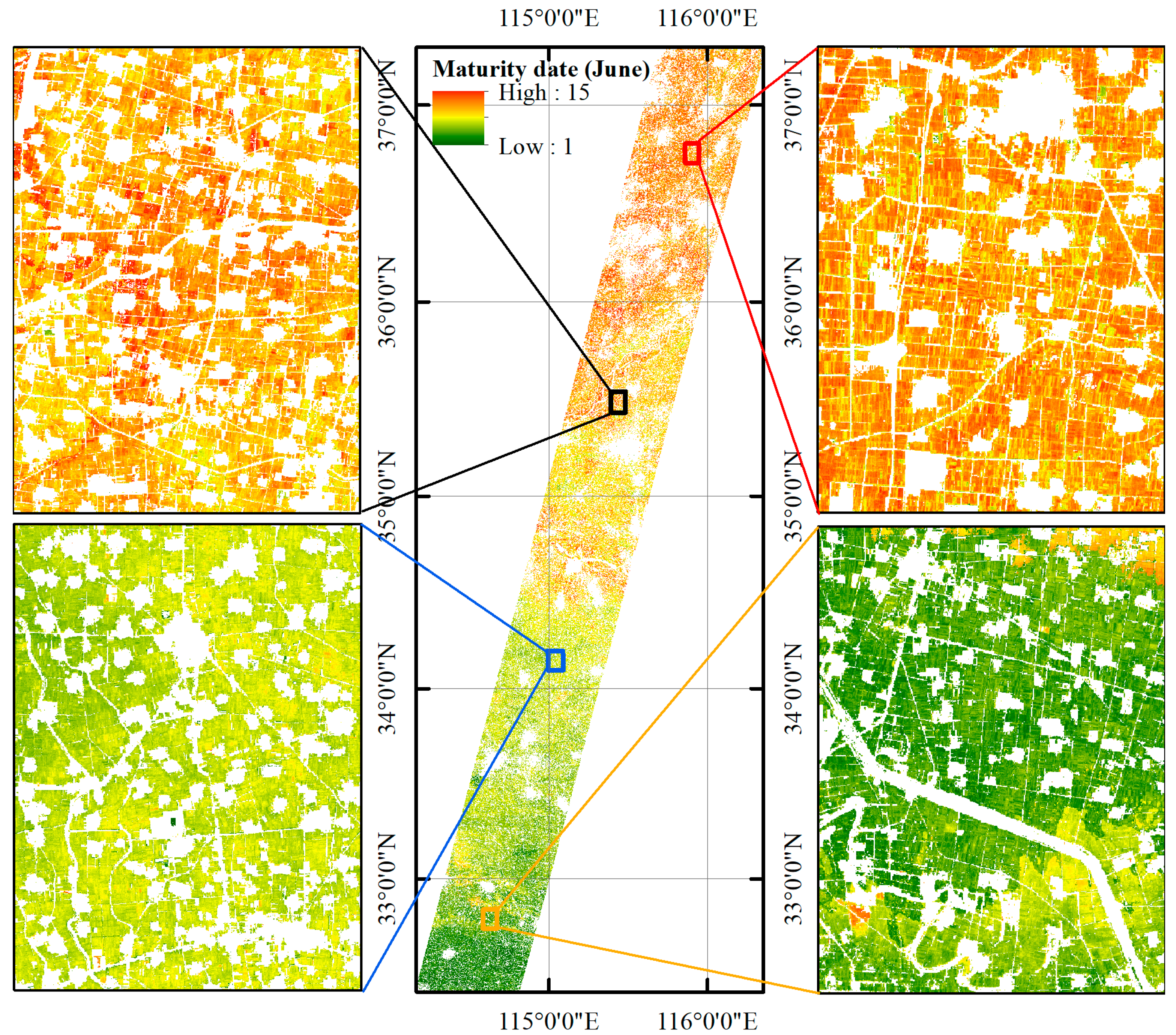

| Type | Label | Number | Description |
|---|---|---|---|
| winter wheat planting area | winter wheat cropland | 600 | winter wheat |
| non-wheat planting area | waterbody | 150 | rivers and lakes |
| road | 150 | cement and dirt roads | |
| urban area | 150 | cities and towns (non-vegetation) | |
| green vegetation-covered | 150 | non-wheat vegetation |
| Abbr | Transit Time | Wheat Growth Stages | Abbr | Transit Time | Wheat Growth Stages |
|---|---|---|---|---|---|
| S1 | 2022-11-15 | emergence | S7 | 2023-03-28 2023-03-30 | flagging |
| S2 | 2022-12-18 | overwintering 1 | S8 | 2023-04-09 | heading |
| S3 | 2023-01-07 | overwintering 2 | S9 | 2023-04-16 2023-04-22 2023-04-24 2023-04-27 2023-04-29 | flowering |
| S4 | 2023-01-29 | overwintering 3 | S10 | 2023-05-07 2023-05-14 | filling |
| S5 | 2023-02-15 2023-02-26 | regreening | S11 | 2023-06-01 2023-06-06 2023-06-08 2023-06-13 | harvest |
| S6 | 2023-03-10 2023-03-13 | jointing |
| Group | Transit Time | Type |
|---|---|---|
| Group 1 | 2023-6-1 | Sentinel-2 MSI |
| Group 2 | 2023-6-6 | Sentinel-2 MSI |
| 2023-6-8 | Sentinel-2 MSI | |
| Group 3 | 2023-6-12 | HJ-2A CCD, GF1-WFV |
| 2023-6-13 | HJ-2B CCD, Sentinel-2 MSI |
| VIs | Types | Calculation Method | Refs. |
|---|---|---|---|
| NDVI | multifunctional | (NIR-RED)/(NIR + RED) | [48] |
| GNDVI | (NIR-GREEN)/(NIR + GREEN) | [49] | |
| NDVI2 | NDVI × NDVI | - | |
| RDVI | (NIR-RED)/((NIR + RED)0.5) | [50] | |
| SAVI | 1.5 × (NIR-RED)/(NIR + RED + 0.5) | [51] | |
| OSAVI | 1.16 × (NIR-RED)/(NIR + RED + 0.16) | [52] | |
| NIRv | NIR × NDVI | [53] | |
| EVI | 2.5 × (NIR-RED)/(NIR + 6 × NIR − 7.5 × BLUE + 1) | [54] | |
| CIRE | chlorophyll | RE3/RE1 − 1 | [55] |
| NDRE | (NIR–RE1)/(NIR + RE1) | [56] | |
| NDII1 | leaf water | (NIR–SWIR1)/(NIR + SWIR1) | [57] |
| NDII2 | (NIR–SWIR2)/(NIR + SWIR2) | [57] |
| Confusion Matrix | Reference | |||
|---|---|---|---|---|
| Winter Wheat | Non-Winter Wheat | Total | ||
| Map | Winter wheat | p11 | p12 | p1 |
| Non-winter wheat | p21 | p22 | p2 | |
| Total | p1 | p2 | 1 | |
| Confusion Matrix | Predicted Value | |||
|---|---|---|---|---|
| Winter Wheat | Non-winter Wheat | Total | ||
| Actual value | Winter wheat | 550 | 50 | 600 |
| Non-winter wheat | 2 | 598 | 600 | |
| Total | 552 | 648 | 1200 | |
Disclaimer/Publisher’s Note: The statements, opinions and data contained in all publications are solely those of the individual author(s) and contributor(s) and not of MDPI and/or the editor(s). MDPI and/or the editor(s) disclaim responsibility for any injury to people or property resulting from any ideas, methods, instructions or products referred to in the content. |
© 2024 by the authors. Licensee MDPI, Basel, Switzerland. This article is an open access article distributed under the terms and conditions of the Creative Commons Attribution (CC BY) license (https://creativecommons.org/licenses/by/4.0/).
Share and Cite
Yue, J.; Li, T.; Shen, J.; Wei, Y.; Xu, X.; Liu, Y.; Feng, H.; Ma, X.; Li, C.; Yang, G.; et al. Winter Wheat Maturity Prediction via Sentinel-2 MSI Images. Agriculture 2024, 14, 1368. https://doi.org/10.3390/agriculture14081368
Yue J, Li T, Shen J, Wei Y, Xu X, Liu Y, Feng H, Ma X, Li C, Yang G, et al. Winter Wheat Maturity Prediction via Sentinel-2 MSI Images. Agriculture. 2024; 14(8):1368. https://doi.org/10.3390/agriculture14081368
Chicago/Turabian StyleYue, Jibo, Ting Li, Jianing Shen, Yihao Wei, Xin Xu, Yang Liu, Haikuan Feng, Xinming Ma, Changchun Li, Guijun Yang, and et al. 2024. "Winter Wheat Maturity Prediction via Sentinel-2 MSI Images" Agriculture 14, no. 8: 1368. https://doi.org/10.3390/agriculture14081368
APA StyleYue, J., Li, T., Shen, J., Wei, Y., Xu, X., Liu, Y., Feng, H., Ma, X., Li, C., Yang, G., Qiao, H., Yang, H., & Liu, Q. (2024). Winter Wheat Maturity Prediction via Sentinel-2 MSI Images. Agriculture, 14(8), 1368. https://doi.org/10.3390/agriculture14081368








